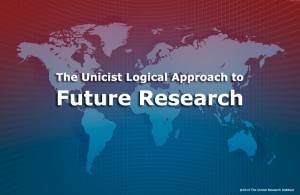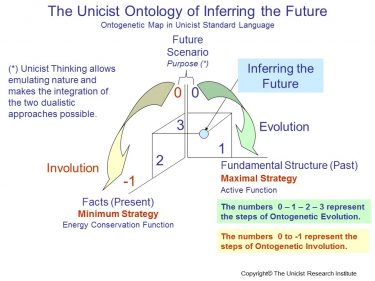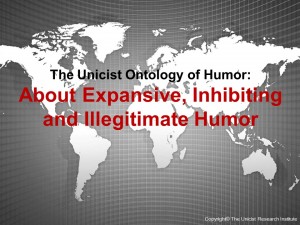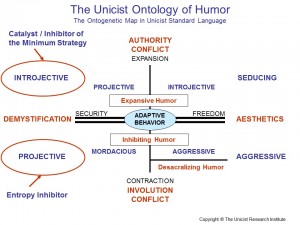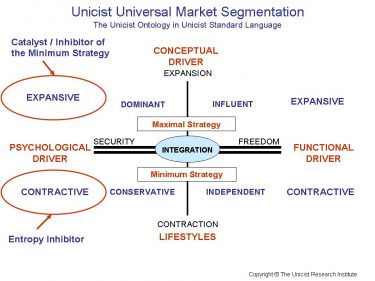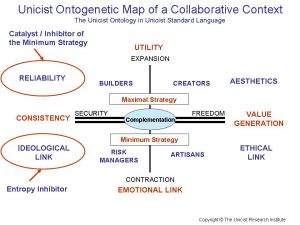The objective of people in the Era of Participation is to find a better place in the world, conserve it, expand it and avoid losing it. This era changes the way people deal with others. It generated a major change of habits that gives access to influential roles to all those who feel that they have something to say and drives towards an increasing transparency of public and private actions.

The reach of one’s globalization is defined
by the limit of the pronoun “WE”…
The unicist future research on the displacement of the “Era of Knowledge” by the “Era of Participation” was triggered by the need of knowing how to influence people in an adapted way. The notorious change in communication technologies, that gave most of the hidden villages in peripheral countries an access to the world, made evident that a new ideology was being introduced.
The research was led by Peter Belohlavek at The Unicist Research Institute using the Unicist Complexity Science Methodology. The research began in 2001 and included: Algeria, Australia, Belgium, Brazil, Canada Chile, China, Colombia, Costa Rica, Egypt, Finland, France, Germany, Holland, India, Israel, Korean Republic, Mexico, New Zealand, Italy, Japan, Norway, Peru, Poland, Russia, Saudi Arabia, Slovakia, South Africa, Spain, Sweden, Switzerland, Tunisia, UK, Ukraine, Uruguay, USA.
The closing of the conclusions was possible based on the experiences with Google, Greenpeace, Facebook, Twitter and LinkedIn.
To access the basics on Unicist Future Research please enter: www.unicist.org/sdp.shtml
Which technologies have given birth to the Era of Participation?
Internet (Sharing)
The sharing capacity of Internet changed the world of communication in the field of work and of pastime activities. Although it began as a tool to work it evolved towards a tool to access and share.
Cell Phones (SMS – Short Message Service)
The communication and influential capacity of messages when they are used to share weaknesses transformed cell phones into a weapon to generate both adaptive and over-adaptive participation.
Facebook – Twitter (Social networks)
Social networks became the natural tool to be used by all the segments of participants (publicity driven, bragging driven, utopia driven, recognition driven, action driven). They made the building and managing of superficial relationships possible, which were not possible before.
Linkedin (Professional Networks)
Professional networks became a way to position individuals in hypothetical roles in order to make them become real personal roles. Their use is based on providing hope to the participants who want to find or improve their place in the world.
Consequences of this New Era:
- The change of the depth of relationships making them basically superficial and based on fallacious myths
- The increasing importance of the word of mouth communication to install ideas
- The increase of the value of charismatic leadership and its dysfunctional counterpart: the “manipulative leadership”
- The substitution of structural participation (institutions) by conjunctural participation
- The loss of credibility of formal authorities and the empowerment of authoritative roles
- The increase of egocentrism and the demand of permanent sensorial and materialistic stimuli
- The increase of addictive behaviors to escape
- The increase of fundamentalist groups to ensure survival (religious, civil, military)
- The multiplication of sectarian movements
- The installation of over-adaptive behaviors as a standard in the world
- The existence of multi-minorities
- The installation of active inaction as a standard in underdeveloped environments
The Increase of the Influence of Public Opinion
Public opinion became the central power in democratic countries. Public opinion is now driven by the new technologies that are available and tends to install a dualistic approach in cultures defined by those who accept something and those who oppose to it.
 As public opinion is intuition driven, this conflict becomes extreme when untrue information or disinformation is used by the parts.
As public opinion is intuition driven, this conflict becomes extreme when untrue information or disinformation is used by the parts.
Public opinion has always integrated the structure of the governmental power integrated by the legislative power, the executive power and the judiciary power.
The role of the legislative power is that of the driver of maximal strategies. In this role, it needs to be compatible with the public opinion but at the same time foster expansion and equality of opportunities.
The executive power has two alternatives in this Era: covering both the needs of expansion and distribution or focusing on distribution becoming a populist government. The extreme situation occurs when Distributism prevails absolutely to sustain the power of the government itself.
The judiciary power equilibrates the conflict between the public opinion, the legislative power and the executive power.
In the Era of Participation, the direct influence of people in governmental decision becomes dominant.
The End of the Era of Knowledge
The Era of Knowledge implied that the access to personal and social evolution was basically sustained by the knowledge individuals had and was demonstrated by their credentials.
But the Era of Knowledge came to an end. An “ERA” is such when it establishes an imperceptible “gravitational force” that sustains the behavior of an environment.
It has to be considered that knowledge began being ruled by religions in order to avoid the deviation of human behavior from the moral rules, but became a value in itself with the appearance of the Industrial Era in the world.
The paradox is that industrialization empowered knowledge but at the end, the Era of Industrialization was exceeded by the Era of Knowledge. Nevertheless, knowledge is still an appendix of religions in pre-industrialized societies.
Internet opened a window that allowed making the access of knowledge massive. It expanded the use of data and information that gave access to any person who lives in a non-marginal environment.
 Information can be defined as any data that can be transformed into a meaningful entity and thus can be stored in the long-term memory of an individual. Knowledge is such when the information one has can be used to produce something.
Information can be defined as any data that can be transformed into a meaningful entity and thus can be stored in the long-term memory of an individual. Knowledge is such when the information one has can be used to produce something.
Google, as a concept, made the access to information basically free for everyone. The paradox is that people now have all the information they are willing to search but the value generation, which is based on knowledge, depends on the concepts they manage.
This explains why the open access to information did not produce a significant increase in productivity and quality of work.
Thus, the functionality of knowledge as a driver for personal evolution became fallacious. Education became a hygienic key; it was necessary to open doors but did not suffice to drive personal evolution and provide a meaningful place in the world.
The occurrence of economic crises in the world was the trigger to the end of the Era of Knowledge. Every economic crisis generates the lack of opportunities for many and the degradation of the ethical intelligence of a culture in order to survive. When crises are not cured, but only palliated, they plant the seed of the next crisis and the degradation of cultures continues.
A consequence of these crises is a growing individualism, which drives people to develop a surviving attitude that diminishes the generation of value and installs an unstable social environment.
Another consequence is the exclusion of youth, the newcomers in societies, diminishing their possibilities to find a social role to evolve.
These consequences gave birth to the Era of Participation, which can be synthesized in a shout:
“I need a better place in the world”
What is the Era of Participation?
The objective of participation is to find a better place in the world, conserve it, expand it and avoid losing it.
What needs to be established is the social role an individual looks for, which can imply a structural or an incidental positioning. It implies that there has to be an acceptance of the reference group the individual accepts as a rule maker.
This reference group can be real, virtual or super-natural. All what matters is that it has to exist in order to make a participative process possible. Without a superior reference group’s acceptance, there is no true place in the world and the participation degrades towards achieving a role of active or passive opposition.
The social role individuals fight for needs to have a belonging group where the individuals feel at home. Belonging groups are what make a place in the world safe. Therefore, participation implies fostering the existence of belonging groups who share similar utopias while they share the same weaknesses they need to cover.
 The participation process becomes redundant when a place in the world, accepted by the reference groups and the belonging group, has been gained. However, as the satisfaction of needs generates new needs this is a never-ending process at an operational level. This process generates social evolution when individuals have a role in the world that allows them to evolve based on the value they add.
The participation process becomes redundant when a place in the world, accepted by the reference groups and the belonging group, has been gained. However, as the satisfaction of needs generates new needs this is a never-ending process at an operational level. This process generates social evolution when individuals have a role in the world that allows them to evolve based on the value they add.
Adaptive Participation
Evolutionary participation requires beginning with a conscious adaptive process where the individual is looking for a place to be who s/he is. This makes the individual a differentiated person that needs to begin by participating through value adding actions (participation to do) while sustaining the identity of the role by having the necessary image that allows others to tag him/her properly (participation to appear).
Participation is only possible when the members who participate are able to recognize each other as part of the same group. In fundamentalist groups this tagging might include tattoos or similar timeless marks but in social groups individuals need to have the necessary “look & feel” in order to be tagged and recognized as members.
This appearance is extremely notorious in social and professional networks that establish the basics of the profile that need to be covered in order for the group to accept a possible member. That is why appearance, which is given by the personal brand or image, is the entropy inhibitor that makes expansive participation possible.
When the image has been positioned, the final objective of being a real member becomes possible.
Over-adaptive Participation
The apparent paradox is that over-adaptation is the minimum strategy. This requires an explanation. Adapting implies influencing while being influenced to achieve a goal, which in this case is to have a place in the world. Influencing is what we call adaptive participation and being influenced is what in this case is named over-adaptive participation.
Over-adaptiveness implies accepting the rules of the environment, which implies submission but beginning with a dominant participation in order to feel that one is not submitting but establishing the rules.
When the self-esteem has been conserved by this dominant participation, which mostly implies active inaction that allows judging the environment, an oppositional role becomes necessary to accept the rules of the game.
When individuals are able to feel superior by judging the environment, opposing to some aspects to preserve their self-esteem, then over-adaptive participation becomes functional. But, this functionality depends on its compatibility with the adaptive participation.
Segments of Participation
 There are different segments or participants that need to be understood in order to deal with them. Accessing profiles and activities on Facebook, Twitter and LinkedIn is very useful to identify the different segments, which are never pure but always have an implicit dominant trend that drives their participation.
There are different segments or participants that need to be understood in order to deal with them. Accessing profiles and activities on Facebook, Twitter and LinkedIn is very useful to identify the different segments, which are never pure but always have an implicit dominant trend that drives their participation.
- Publicity Driven
- Bragging Driven
- Utopia Driven
- Recognition Driven
- Action Driven
Conclusions
Paradoxically, the Era of Participation implies a prevalence of observation over true participation. This implies that this Era will represent implicitly a battle between observers and participants.
Over-adaptive participation is based on an observational attitude while adaptive participation is based on the synergy of the members to produce something.
The preexisting Era of Knowledge will be included as a secondary driver during the next decades to sustain, on the one hand, those who participate to build and, on the other hand, to sustain those who participate to expose the implicit weaknesses of the adaptive participants.
This makes this period a battle and an integration of these two groups. Dualism will be the driver for the mass that over-adapts while integralism will be the driver for the elites who adopt an adaptive participative approach. It is a battle of communication.
Adaptive Participation Building
The building of adaptive participation is the responsibility of the elite of cultures. It is an institutional role that needs to exist in order to make participative behavior meaningful.
 The purpose of adaptive participation building is to establish an influential social capital. Social capital is given by the strengths of the bonds among the members of a group or community that drive their value generating actions. Social capital implicitly implies the existence of a greater good to sustain the relationships among the members.
The purpose of adaptive participation building is to establish an influential social capital. Social capital is given by the strengths of the bonds among the members of a group or community that drive their value generating actions. Social capital implicitly implies the existence of a greater good to sustain the relationships among the members.
Adaptive participation requires the existence of a double ethical behavior in the community. On the one hand, there has to exist an internal ethics of the group which needs to be based on cooperativeness and, on the other hand, an external ethics with the environment is required, which needs to be driven by competitiveness in order to ensure survival.
This is evident in the behavior of countries that naturally have two different attitudes: one towards the environment and another towards the members of the culture. However, both ethics need to be integrated by a social capital, which establishes the participation rules for the members of the group towards other members and towards the environment.
If cooperation is replaced by competition among the members of a group or community, the social capital becomes corrupt and over-adaptiveness replaces adaptiveness.
Corruption and over-adaptiveness also prevails when competition is based on the destruction of the environment in order to take advantage of it.
Adaptiveness drives towards evolution and over-adaptiveness is the cause and consequence of involution.
If you want to access more information about this study please contact n.i.brown@unicist.org
Unicist Press Committee
NOTE: The Unicist Research Institute was the pioneer in using the unicist logical approach in complexity science research and became a private global decentralized leading research organization in the field of human adaptive systems. It has an academic arm and a business arm.http://www.unicist.org/turi.pdf
 The consensus of an evolutionary culture is oriented towards growth, which implies having a proactive attitude in the environment to generate value. Social efficiency means that the system is institutionalized having therefore a minimum level of entropy.
The consensus of an evolutionary culture is oriented towards growth, which implies having a proactive attitude in the environment to generate value. Social efficiency means that the system is institutionalized having therefore a minimum level of entropy.


